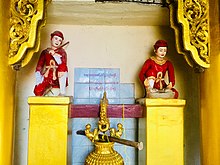Zawgyi (alchemist)

Zawgyi (Burmese: ဇော်ဂျီ) is a semi-immortal human alchemist and mystic with supernatural powers and often seen with a magic stick and a red hat. Zawgyi is one of the supernatural figures in Burmese mythology and folklore.[1]
Legend and powers[edit]

Zawgyi has supernatural powers such as flying through the air, travelling beneath the earth and oceans, as well as performing divination, necromancy and resurrection. He dwells alone in Himavanta, an invisible mythical forest set deep in the Himalaya Mountains, where he forages herbs for magical purposes. After searching for many years he obtained the mythical Philosopher's stone and thereby gained Zawgyihood.
Sometimes, with a touch of his magic wand he brings to life "illusory females" (Thuyaung-mèý) from Nariphon (Thuyaung fruit trees) bearing female-shaped fruits in order to fulfill his carnal wishes. He gained it by medicines derived from trees, roots, tubers and bulb of deep forests and legendary ball of mercury which possesses supernatural powers. They spend their lives searching for herbs to treat suffering humans and to attain longevity. They use the magic wand to grind the medicinal herbs and roots and any round flat stone found miles from anywhere are believed to be the Zawgyi's grinding stones. He always has a staff in his hand, which he would use during his walks especially in negotiating along very rugged footpaths.[2]
Zawgyi practices alchemy to become Weizza and attain immortal life, along with lesser attainments such as supranormal powers. The goal of this practice is to achieve the timeless state of the Weizza, who awaits the appearance of the future Buddha, Metteya.
Costume[edit]
Zawgyi are dressed in red from head to toe with a red hat and a magic wand in hand. There are only male Zawgyis. Mustache is an optional part of the costume. Zawgyi becomes a Weizza (Master Wizard, technically super Zawgyi), he would change his dress to white and would change his trousers for a white Burmese longyi.
Zawgyi dance and choreography[edit]
Zawgyi dance is basically a happy dance to portray how he grinds medicines with the wand and how he finally created a magic pill. Therefore, nearing to the end of the performance, he performs this choreography where he holds the wand horizontally and jumps across it to show his success.
References[edit]
- ^ "Old Burmese Puppet Character Zawgyi Magician Alchemist". Golden Triangle Antiques. Retrieved 29 July 2018.
- ^ "Elements in Burmese Buddhism" (in Burmese). tuninst.net. 8 September 2016. Retrieved 29 July 2018.
Bibliography[edit]
- Aung, Maung Htin (1933). "Alchemy and Alchemists in Burma". Folklore. 44 (4): 346–354. ISSN 0015-587X.
- Collins, Steven (1998). Nirvana and Other Buddhist Felicities: Utopias of the Pali Imaginaire. Essays on Burma. Cambridge Univ. Press. ISBN 9780521570541.
- Ferguson, John P.; Mendelson, E. Michael (1981). Masters of the Buddhist Occult: The Burmese Weikzas. Essays on Burma. Brill Archive. ISBN 978-90-04-06323-5.
